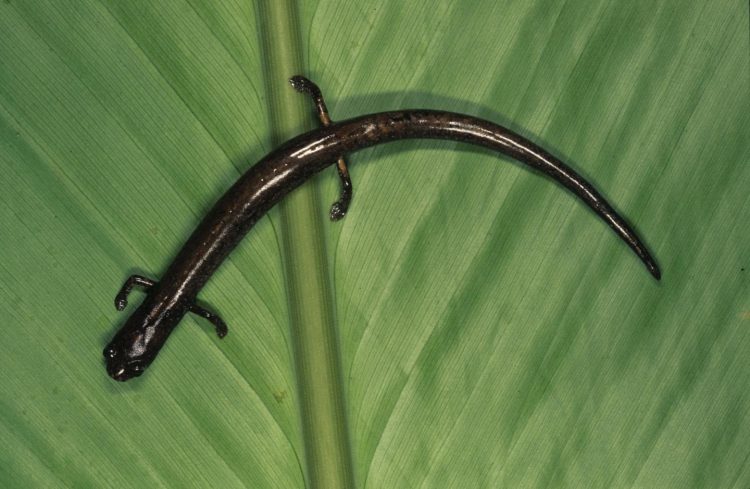Ancient connection between the Americas enhanced extreme biodiversity

Scientists think that salamanders from North America arrived in South America before the accepted date for the closure of the Isthmian land bridge 3 million years ago, supporting Bacon et al's assertion that the Isthmus closed at an earlier date. Credit: STRI Archives
A new study by Smithsonian scientists and colleagues published this week in the Proceedings of the National Academy of Sciences shows that species migrations across the Isthmus of Panama began about 20 million years ago, some six times earlier than commonly assumed. These biological results corroborate advances in geology, rejecting the long-held assumption that the Isthmus is only about 3 million years old.
“Even organisms that need very specific conditions to survive, such as salamanders and freshwater fishes, crossed the Isthmus of Panama over 6 million years ago,” said lead author, Christine Bacon, former post-doctoral fellow in staff scientist Carlos Jaramillo's group at the Smithsonian Tropical Research Institute. “These early migrations impact our understanding of how and when biodiversity in the Americas took shape.”
The Isthmus of Panama, which links North and South America, plays a crucial role in the planet's atmospheric and oceanic circulation, climate and biodiversity. Despite its importance across multiple disciplines, the timing of the formation and emergence of the Isthmus and the effect it had on those continents' biodiversity is controversial.
In the new study, Bacon, now at the University of Gothenburg in Sweden, examines a large number of molecular studies and fossils, including land and aquatic organisms.
Models based on molecular genetic data indicate that rather than one great migration following a set closure time, there were several periods in which animals and plants moved across the intercontinental land bridge. There are shifts in the rate of movement of animal fossils moving from North America to South America at 23 million and within the past 10 million years.
Authors also compare the proportion of immigrants in each direction to sea level and global mean temperature, showing that migrations may have coincided with low sea levels.
A known date for the rise of the Isthmus is important to evolutionary biologists who want to understand how species of marine organisms diverged and when species of terrestrial organisms moved from one continent to another. The date is also critical in understanding ancient climate change patterns.
The 3 million year date was established by the Panama Paleontology Project, headed by Jeremy Jackson and Anthony Coates, also at the Smithsonian Tropical Research Institute.
###
The Smithsonian Tropical Research Institute, headquartered in Panama City, Panama, is a part of the Smithsonian Institution. The institute furthers the understanding of tropical nature and its importance to human welfare, trains students to conduct research in the tropics and promotes conservation by increasing public awareness of the beauty and importance of tropical ecosystems.
Website: http://www.
Bacon, C.D., D. Silvestro, C.A. Jaramillo, B. Tilston Smith, P. Chakrabarty, A. Antonelli. Biological evidence shows earlier emergence of the Isthmus of Panama. Accepted, Proceedings of the National Academy of Sciences USA. doi:10.1073/pnas.1423853112
Media Contact
All latest news from the category: Life Sciences and Chemistry
Articles and reports from the Life Sciences and chemistry area deal with applied and basic research into modern biology, chemistry and human medicine.
Valuable information can be found on a range of life sciences fields including bacteriology, biochemistry, bionics, bioinformatics, biophysics, biotechnology, genetics, geobotany, human biology, marine biology, microbiology, molecular biology, cellular biology, zoology, bioinorganic chemistry, microchemistry and environmental chemistry.
Newest articles

First-of-its-kind study uses remote sensing to monitor plastic debris in rivers and lakes
Remote sensing creates a cost-effective solution to monitoring plastic pollution. A first-of-its-kind study from researchers at the University of Minnesota Twin Cities shows how remote sensing can help monitor and…

Laser-based artificial neuron mimics nerve cell functions at lightning speed
With a processing speed a billion times faster than nature, chip-based laser neuron could help advance AI tasks such as pattern recognition and sequence prediction. Researchers have developed a laser-based…

Optimising the processing of plastic waste
Just one look in the yellow bin reveals a colourful jumble of different types of plastic. However, the purer and more uniform plastic waste is, the easier it is to…



